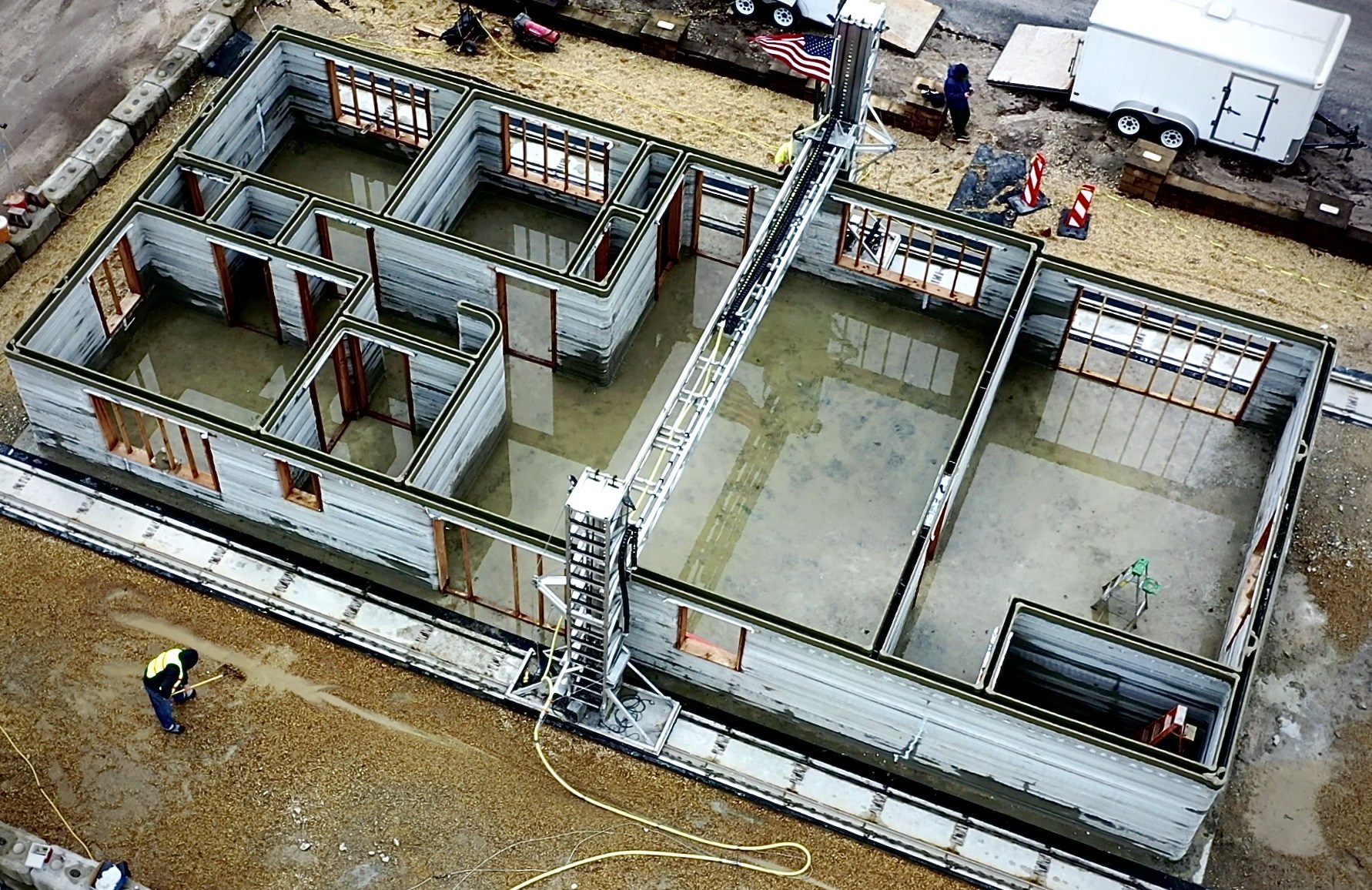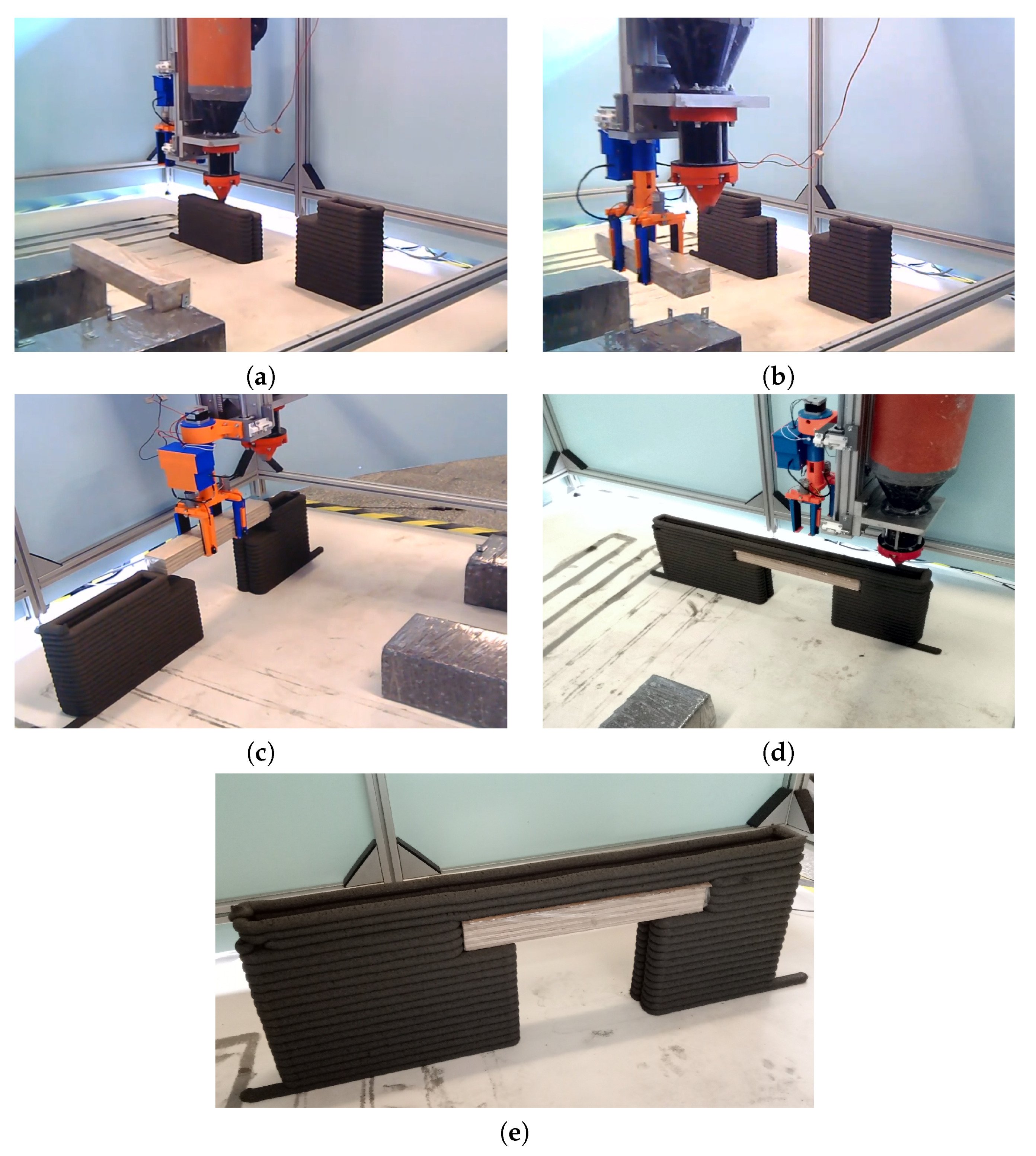Researchers from the West Pomeranian University of Technology (ZUT) in Poland have produced a study on the automation of 3D printing construction, while also investigating methods of improving the process in regards to the rheological properties of the concrete mix.
Specifically, the study details the application of additive manufacturing technology in the fabrication of a building wall model, in which the door opening was finished with an automated lintel installation. A lintel is a beam placed across openings in buildings like doors, windows etc. to support the load from the structure above.
The objective of the study was to improve the low capacity of 3D printed concrete mixes to transfer loads, which can be particularly troublesome in cases of external components that need to be placed on top such as precast lintels or floor beams during 3D printing construction processes.
Such an investigation, according to the researchers, can prove beneficial in designing larger civil structures using concrete 3D printing technology.

The advantages of construction 3D printing
The study sets out by explaining that developments in construction technology have been focused on speeding up the construction of buildings and structures through automation. A technology at the forefront of this development is additive manufacturing using concrete mixes, which allows the building up of a structure by extruding a concrete mix layer by layer.
“Considering that the formwork can constitute to 35–54% of total costs of raising concrete structure. The application of additive manufacturing brings measurable profits. Not only does it allow production of structures without the formwork, but it also reduces total production time, costs and labor. The technology also increases the safety of workers on the construction site, produces less waste and uses raw materials with low embodied energy,” explain the authors of the study.
Indeed, recently the field of construction 3D printing has seen a number of initiatives and projects unfold which enabled the building of large structures in a short amount of time compared to traditional construction processes. For example SQ4D, an offshoot of the New York-based S-Squared 3D Printers (SQ3D), recently completed construction of a new building, in what it claims is the “largest permitted 3D printed home in the world.” Spanning 1900 square feet, construction of the 3D printed home reportedly took place over an eight-day period, with a total of 48 hours in print time.
New Story, a non-profit organization fighting homelessness and ICON, a Texas-based construction technologies company, have also begun an initiative seeking to create the ‘world’s first’ 3D printed community of concrete homes. First announced in 2018, the 3D printed homes are intended to provide low-cost housing for low-income communities in Latin America that adapt to their day-to-day lives. Thus far two houses have now been 3D printed by ICON and New Story in Tabasco; each was completed in around 24 hours of print time and measures 500 sq ft. 3D printing was identified by New Story as a way to provide homes for these families at a faster pace.

Rheological properties of concrete in construction 3D printing
Discussing the additive manufacturing of structures, the ZUT researchers explain in their research the importance of ensuring a correlation between the increase of the load caused by additional printed layers, and the growth of the strength of layers already placed during the process of curing. Explaining further, the authors write: “From this point of view, it is important to determine the appropriate extrusion speed, which makes it possible to obtain sufficient strength for each layer by the time the printing head returns to its home position, the layer needs to withstand the load imposed by layer deposited on top.” As such, a central challenge in 3D printing is to obtain a mix with desired rheological properties, in order to ensure a proper printing process.
The purpose of the study is to therefore present the additive manufacturing of a scaled down wall model with a door opening, including the automated installation of a lintel. Specifically, the research adjusts the wall design and printing process to account for the rheological and mechanical properties of the fresh concrete, as well as the process of the automated lintel installation.
3D printing set-up. Photo via Materials 2020.The researchers aim to demonstrate that the automated process can be designed with high accuracy, as confirmed by simulation. They constructed the wall at a specially designed site, consisting of a 3D robot connected to a pumping module. The 3D printer and printing head motions were controlled by a G-code, whereas the mix was prepared in a laboratory mixer and transferred to the pump unit, from where it was delivered to the printing head hopper through a hose.
As part of the experiment, a special gripper was built in order to automatically transfer the lintel and install it on the wall in the determined position. The lintel placement via the gripper took place as the 3D printing robot was running, with the printing process recommencing as soon as they were completed. The concrete mix used in the experiments was designed on the basis of ensuring its optimal rheological properties for the 3D printing process. It had a 0.23 water-cement ratio and a density of 2168 kg/m³.

After successfully 3D printing the scale model wall, the researchers were able to confirm the possibility of automating the wall construction process in additive manufacturing with the installation of a lintel with a special gripper. It was also proven that the printer can be used for placing precast elements during the whole process of printing. Significantly, the researchers also confirmed that the rheological properties of fresh concrete are of higher significance in 3D printing construction, than in the case of conventional concrete construction, due to the specific process characteristics involved.
Concluding the paper, the researchers state “There are currently several experimental projects being carried out at different research centers, investigating the desired mechanical and rheological properties of concrete mixes and their behavior during the printing process. Further research concerning mix properties and 3D printing strategies will result in the development of design and construction procedures, which will ensure the required level of printed construction structural safety.”
The paper, ‘Automation in the Construction of a 3D-Printed Concrete Wall with the Use of a Lintel Gripper’, is written by Marcin Hoffmann, Szymon Skibicki, Paweł Pankratow, Adam Zieliński, Mirosław Pajor and Mateusz Techman. It is published in the journal Materials.
The nominations for the 2020 3D Printing Industry Awards are now open. Who do you think should make the shortlists for this year’s show? Have your say now.
Subscribe to the 3D Printing Industry newsletter for the latest news in additive manufacturing. You can also stay connected by following us on Twitter and liking us on Facebook.
Looking for a career in additive manufacturing? Visit 3D Printing Jobs for a selection of roles in the industry.
Featured image shows the steps for printing a wall with a lintel. Photo via Materials 2020.



